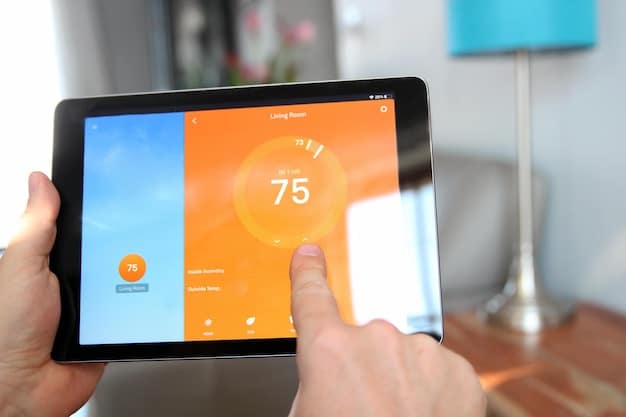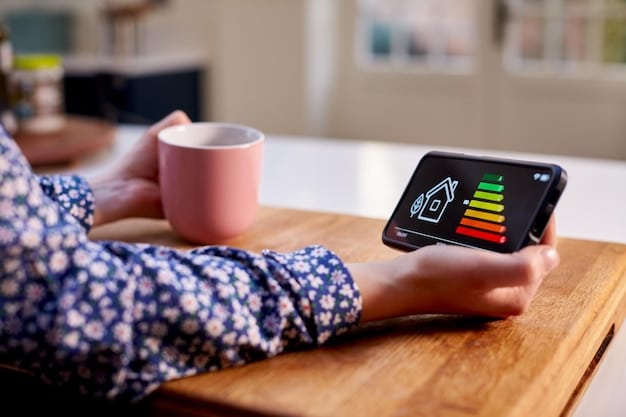Smart Home Energy Management: Real-Time Control & Savings

Smart Home Energy Management involves using technology to monitor and control your home’s energy usage in real-time, leading to greater efficiency, cost savings, and a reduced environmental impact.
Are you ready to take control of your home’s energy consumption and reduce your utility bills? Smart Home Energy Management systems provide the tools and insights you need to monitor and control your energy usage in real-time, making your home more efficient and saving you money.
Understanding Smart Home Energy Management
Smart Home Energy Management (SHEM) is more than just a buzzword; it’s a comprehensive approach to optimizing your home’s energy consumption. By integrating smart devices and a central control system, you gain unprecedented insight into how and when energy is used in your home.
This understanding allows you to make informed decisions about energy usage, leading to significant savings and a smaller carbon footprint. Let’s delve deeper into the key aspects of SHEM.
What is Smart Home Energy Management?
At its core, SHEM involves using technology to monitor, automate, and control energy-consuming devices in your home. These devices can include smart thermostats, lighting systems, appliances, and even electric vehicle chargers.
Why is it Important?
SHEM is crucial for several reasons. It empowers you to reduce energy waste, lower utility bills, and contribute to a more sustainable environment. Moreover, some utility companies offer rebates and incentives for homeowners who implement SHEM systems.

By understanding the principles of SHEM, you’re taking the first step towards creating a more energy-efficient and cost-effective home. The benefits extend beyond just saving money; they contribute to a more sustainable lifestyle.
Benefits of Real-Time Energy Monitoring
Real-time energy monitoring is a cornerstone of effective smart home energy management. It provides immediate feedback on energy usage, allowing you to identify inefficiencies and make adjustments on the fly.
This capability is a game-changer compared to traditional methods of tracking energy consumption, which often rely on monthly utility bills that offer a delayed and aggregated view of energy usage.
- Immediate Feedback: See how much energy you’re using at any given moment.
- Identify Energy Vampires: Discover appliances and devices that consume energy even when not in use.
- Optimize Usage: Adjust your habits and settings to reduce energy consumption during peak hours.
- Prevent Waste: Quickly identify and address any unexpected spikes in energy usage.
Real-time monitoring gives you granular control over your energy consumption, empowering you to make informed decisions and achieve significant savings. It’s all about having the right information at your fingertips.
Key Components of a Smart Home Energy Management System
A fully integrated SHEM system consists of several key components that work together to monitor, automate, and control your home’s energy usage. These components include smart devices, a central control hub, and a user-friendly interface.
Understanding the function of each component is crucial for building an effective and customized SHEM system that meets your specific needs and preferences.
Smart Thermostats
Smart thermostats learn your heating and cooling patterns. Can be programmed to automatically adjust the temperature based on occupancy and weather conditions.
Smart Lighting
Smart bulbs and switches allow you to control your home’s lighting remotely. Can be dimmed, scheduled, and even controlled by voice commands.
Smart Plugs and Outlets
These devices can turn appliances and electronics on or off remotely. Also monitor their energy consumption.

These key components form the backbone of a smart home energy management system, providing the tools you need to take control of your energy usage. The integration of these devices creates a seamless and efficient ecosystem.
How to Control Your Energy Usage in Real-Time
Controlling your energy usage in real-time involves several steps, from setting up your SHEM system to monitoring your energy consumption patterns and making necessary adjustments. It’s an ongoing process of learning and optimization.
However, with the right tools and strategies, you can effectively manage your energy usage and achieve significant savings. Let’s explore some practical tips for controlling your energy usage in real-time.
- Set Up a Centralized Dashboard: Use a smart home hub or app to view and adjust all your energy-consuming devices in one place.
- Create Schedules: Program your thermostat, lighting, and appliances to operate only when needed.
- Monitor Energy Consumption Patterns: Use real-time data to identify areas where you can reduce energy waste.
- Adjust Settings: Fine-tune your settings based on real-time feedback and historical data.
By following these steps, you can effectively control your energy usage in real-time and create a more energy-efficient home. Real-time control is about being proactive rather than reactive when it comes to energy consumption.
Tips for Maximizing Energy Savings with Smart Home Technology
While implementing a SHEM system is a great first step, maximizing your energy savings requires ongoing effort and attention to detail. There are several strategies you can employ to optimize your energy consumption and get the most out of your smart home technology.
These tips include optimizing your thermostat settings, utilizing smart lighting features, and being mindful of appliance usage. Let’s explore some practical tips for maximizing your energy savings.
Optimize Thermostat Settings
Program your thermostat to adjust the temperature based on occupancy and weather conditions. Consider using a geofencing feature to automatically adjust the temperature when you leave or approach home.
Utilize Smart Lighting Features
Use smart bulbs and switches to dim or turn off lights in unoccupied rooms. Schedule your lights to turn on or off automatically based on the time of day.
Mindful Appliance Usage
Unplug appliances and electronics when not in use to avoid phantom energy consumption. Use smart plugs to remotely turn off devices that you often forget to unplug.
By implementing these tips, you can significantly maximize your energy savings with smart home technology. It’s all about being proactive and making small changes that add up over time.
Future Trends in Smart Home Energy Management
The field of smart home energy management is constantly evolving, with new technologies and innovations emerging all the time. As the demand for energy efficiency grows, so does the potential for SHEM systems to become even more sophisticated and effective.
Understanding these future trends can help you make informed decisions about your SHEM investments and stay ahead of the curve. Let’s explore some exciting developments in the world of smart home energy management.
- Integration with Renewable Energy Sources: Managing energy generated from solar panels and wind turbines.
- Advanced Data Analytics: AI-powered insights into energy consumption patterns.
- Smart Grids: Seamless integration with utility grids for optimized energy distribution.
- Voice Control and Automation: Hands-free control of energy-consuming devices.
The future of smart home energy management is bright, with endless possibilities for innovation and improvement. By staying informed and embracing new technologies, you can continue to optimize your energy consumption and contribute to a more sustainable future.
| Key Point | Brief Description |
|---|---|
| 💡 Real-Time Monitoring | Immediate insight into energy consumption. |
| 💰 Cost Savings | Lower utility bills through efficient usage. |
| 🌱 Sustainability | Reduced carbon footprint and environmental impact. |
| 🤖 Automation | Automated control of devices for optimal efficiency. |
Frequently Asked Questions
▼
Smart home energy management involves utilizing technology to monitor and controlenergy usage in your home in real-time, leading to cost savings and efficiency.
▼
Smart thermostats learn your heating/cooling patterns & automatically adjust temperature settings based on occupancy and weather conditions, preventing energy waste.
▼
Yes, most smart home energy systems can be controlled remotely via a smartphone app or web interface, allowing you to manage your energy usage from anywhere.
▼
Energy vampires are appliances/devices that consume energy even when not in use; you can eliminate them by unplugging them or using smart plugs to turn them off remotely.
▼
Utility companies often provide rebates/incentives for homeowners who implement smart home energy management systems, check with your local utility provider for available programs.
Conclusion
Smart Home Energy Management empowers homeowners to take control of their energy consumption, reduce costs, and contribute to a more sustainable future. By understanding the principles of SHEM, investing in the right technology, and adopting energy-efficient habits, you can transform your home into an energy-saving powerhouse.





